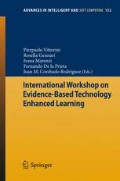Abstract
The research on educational technologies is continuously growing and their application demands an additional effort to instructors. The current work describes the use of concept maps and patterns to provide a better support to instructors in the design of their technology-enhanced learning scenarios. The combination of both representation mechanisms has been applied in a Higher Education context based on the use of digital-ink technologies. The obtained outcomes reveal, first, the contribution of concept maps to represent technology-enhanced learning scenarios from a generic point of view and second, the feasible design of specific learning scenarios based on digital-ink patterns which have been generated from previous concept maps.
Access this chapter
Tax calculation will be finalised at checkout
Purchases are for personal use only
Preview
Unable to display preview. Download preview PDF.
References
Dyrli, O.E., Kinnaman, D.E.: Teaching effectively with technology: What every Teacher needs to know about technology, Technology and Learning magazine (1995)
Wenglinsky, H.: Using technology wisely: the keys to success in schools. Teachers College Pres, New York (2005)
Conole, G., Weller, M.: Using learning design as a framework for supporting the design and reuse of OER. Journal of Interactive Media in Education 5 (2008)
Agostinho, S.: The use of visual learning design representation to document and communicate teaching ideas. In: Proceedings of ASCILITE, Sydney (2006)
Buendía, F., Díaz, P.A.: Framework for the Management of Digital Educational Contents. Educational Technology & Society 6(4), 48–59 (2003)
Huettel, L.G.: Transcending the traditional: Using Tablet PCs to enhance engineering and computer science instruction. In: 37th ASEE/IEEE Frontiers in Education Conference (2007)
Anderson, R., Davis, P., Linnell, N., Prince, C., Razmov, V., Videon, F.: Classroom Presenter: Enhancing Interactive Education with Digital Ink. Computer 40(9), 56–61 (2007)
Figl, K., Derntl, M., Caeiro Rodriguez, M., Botturi, L.: Cognitive effectiveness of visual instructional design languages. J. Vis. Lang. Comput. 21(6) (2010)
Novak, J.D.: Learning, creating, and using knowledge: Concept maps as facilitative tools in schools and corporations. Lawrence Erlbaum Associates, Mahwah (1998)
Buendia, F.: Supporting the Generation of Guidelines for Online Courses. Journal of e-Learning and Knowledge Society 7(3), 51–61 (2011)
Alexander, C., Ishikawa, S., Silverstein, M.: A pattern language: Towns, buildings, construction. Oxford University Press, Oxford (1977)
Hernández, D., Asensio, J.I., Dimitriadis, Y., Villasclaras, E.: Diagrams of learning flow patterns’ solutions as visual representations of refinable IMS learning design templates. In: Handbook of Visual Languages for Instructional Design, pp. 395–413. IGI Group (2007)
Goodyear, P.: Educational design and networked learning: Patterns, pattern language and design practice. Australasian Journal of Education Technology 21(1), 82–101 (2005)
Higher Education HP Technology for Teaching Grant Initiative Recipients (2008)
Author information
Authors and Affiliations
Corresponding author
Editor information
Editors and Affiliations
Rights and permissions
Copyright information
© 2012 Springer-Verlag Berlin Heidelberg
About this paper
Cite this paper
Buendía-García, F., Benlloch-Dualde, J.V. (2012). Concept Maps and Patterns for Designing Learning Scenarios Based on Digital-Ink Technologies. In: Vittorini, P., Gennari, R., Marenzi, I., de la Prieta, F., Rodríguez, J. (eds) International Workshop on Evidence-Based Technology Enhanced Learning. Advances in Intelligent and Soft Computing, vol 152. Springer, Berlin, Heidelberg. https://doi.org/10.1007/978-3-642-28801-2_4
Download citation
DOI: https://doi.org/10.1007/978-3-642-28801-2_4
Publisher Name: Springer, Berlin, Heidelberg
Print ISBN: 978-3-642-28800-5
Online ISBN: 978-3-642-28801-2
eBook Packages: EngineeringEngineering (R0)

